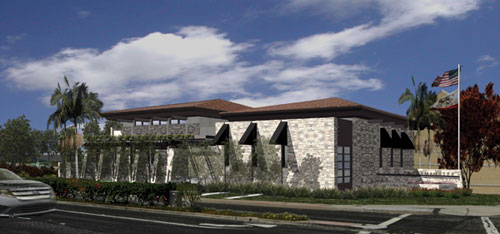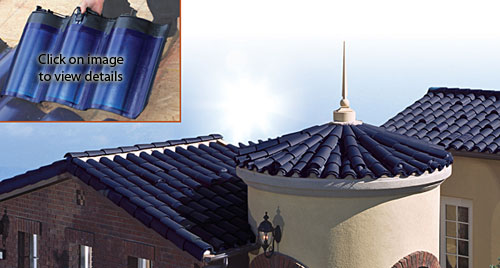Roofing Strategies Reach New Heights: Sustainable Options for a Key Building Element
The extra LEED point for Cradle to Cradle certification helped push the 39,000-square-foot athletic building on the Santa Margarita Catholic High School campus in Rancho Santa Margarita, California, closer to LEED silver certification. Architect Jon Gomer LEED AP of tBP/Architecture in Newport Beach specified a "cool" clay tile roof to match surrounding buildings. "We chose a through-color tile rather than one with a painted-on surface because it would last throughout the building's life cycle," says Gomer. "That it was also a ‘cool' roof product made it the right choice to pursue LEED credit points. And as an added bonus, the Cradle to Cradle certification qualifies the building for an additional Innovation Design point - and that's a plus you don't currently find with other clay tile."
 |
The Westminster, California, Chamber of Commerce building features a barrel tile roof that contributes to LEED Gold certification. Image courtesy of Dougherty + Dougherty Architects LLC |
Â
 In its new Chamber of Commerce Building, the City of Westminster, California, sought to set a standard for contextual and sustainable design as a community-wide goal, and targeted LEED Gold certification from the outset. An integral part of the strategy was a sustainable roof. Dougherty + Dougherty Architects LLP of Costa Mesa specified a clay tile roof with the barrel profile and variegated texture prevalent in the community and consistent with city's traditional design preferences. "The roof was self venting, exceeded LEED SRI criteria and was cost competitive, which is where the rubber meets the road," says Dougherty + Dougherty Partner-in-Charge Betsey Olenick Dougherty, FAIA, LEED AP. "To achieve a green advantage with what is considered to be a traditional material is truly a breakthrough." The project is in construction, with LEED criteria embedded into the specifications. "Architects are in an extremely powerful position to implement a green agenda," Dougherty adds.
Clay Goes Solar
The newest innovation in clay tile roofing is a recently launched building-integrated photovoltaic roofing product (BIPV) that uses flexible thin film solar cells. The thin film laminate is bonded to the polymer tile with a proprietary adhesive material and process to produce the first curved solar tile to be introduced to the U.S. marketplace. They look like standard Mission clay tile and are light weight and easy to install. The thin film solar tiles are currently available in a "solar blue," barrel-shaped profile that mesh seamlessly with blue-glazed tiles of a similar profile, or in a profile-only integration with clay tile of earthen hues. They have been tested under harsh conditions for durability, including UV stability, color fastness, wind resistance, electrical output, safety, and extreme mechanical stresses. UL and ICC code approvals are anticipated this fall. "It's a quantum step for solar energy," says Thomas. "The question has always been: how do you incorporate a solar cell without sacrificing curb appeal."Â Â
While solar systems are typically installed by the watt, energy is generated and billed by the kilowatt hour (kWh). The value of a solar system then, or its rate of return, is dependent on how many kilowatt-hours it generates, offsetting electrical consumption. In order to determine how much energy the solar system will generate the following must be considered: solar capacity of the system, peak sun hours, system efficiency, and time. Based on these considerations, over a year period, the thin film technology allows the tile system to produce an estimated 10 to 15 percent more energy than silicon panels. "This thin film technology is comprised of three layers of semi-conductor material," says Abby Nessa Feinstein of SRS Energy in Philadelphia, noting that each layer absorbs a different spectrum of light, allowing the cells to convert a broader spectrum of light into electricity. "The light spectrum at dusk is different than that the spectrum at 10 o'clock, noon, so and so forth. And the spectrum is different under cloudy conditions. In essence these cells are ‘less picky' than traditional silicon wafers with regards to which light they convert to electricity," Feinstein adds.
With regard to determining the system size, a number of factors come into play, including location, electrical equipment, demand, etc. According to Feinstein, the average American home uses over 10,000 kWh per year. Assuming this and other typical parameters, in California, an estimated 25 percent of the roof covered by these thin film solar panels could reduce the dwelling's energy bill by 75 percent.

|
Solar tiles integrate with clay tiles for a seamless look. Photos courtesy of SRS Energy |









